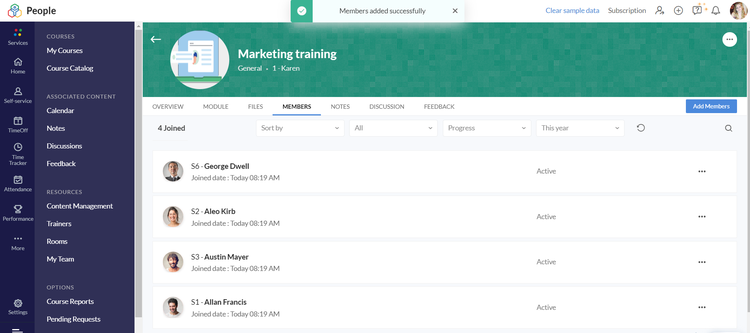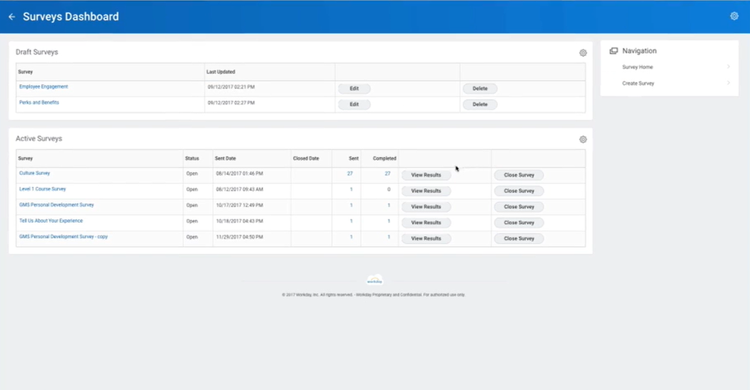Training and development budgets are on the rise. Finally, businesses are waking up to the importance of learning; they are realizing it isn’t a waste of time and resources, or that it’s impossible to measure the return on investment.
While enterprises with bigger budgets and more resources are leading the way, that doesn’t mean your small business should fall behind. With the right strategy and tools, you can create training that makes a real difference to your business’s bottom line and your employees’ happiness and motivation.
Why you should have employee training and development for your small businesses
Training is not a cost center; it can be incredibly beneficial to your business if deployed in the right way. Here are the main benefits that you can gain from investing in training and development. And here’s a spoiler: It’s a win-win situation for you and your employees.
1. Improve employee retention
Learning and development is a priority for employees, with 94% of employees saying they would stay with a company longer if there was an investment in learning. If you want to retain your top talent while ensuring they are motivated to work to the best of their abilities, then you need to invest in staff training.
If you show your employees that you care about their future and that you’re willing to invest in their progression, they are going to be much happier.
Not only will your employee satisfaction levels shoot up, but you’ll also make sure your employees aren’t stagnating, and have the skills that make them more useful to your business than ever before.
Even if they do quit, they’ll be leaving with a positive experience of your company. And they might also tell their friends and former colleagues just how great you are, which will make recruiting your next crop of talent much easier.
2. Future-proof your business
If you have long-term company goals and an employee management plan, you will likely already have performed a skills gap analysis to identify areas where you need to develop new skills.
Even if you haven’t looked that far into the future, you’ll still have some idea of the direction of your business and the skills you need to support this.
There’s a skills shortage at the moment, and it’s a concern. More than three-quarters of CEOs are worried that a lack of essential skills in their workforce is threatening the future growth of their organization.
Instead of trying to recruit for new workers to fill these skills gaps, start training employees in the skills you need in the short- and long-term.
3. Save time and money
Hiring new employees is more expensive than retaining existing workers and it’s time consuming. You also don’t know whether the employee will fit in and enjoy working at your company or if they will be out the door after a few months.
Employee training can save you this time and money by developing the necessary skills in-house, rather than having to recruit externally.
Five strategies for effective employee training and development
Below are five strategies that can help you get your training and development efforts off the ground and that will help you save time and money, increase retention rates, and future proof your business.
1. Get management buy-in
Your training program needs support from the top if it is to succeed. Management needs to champion the program, giving employees the time, motivation, and opportunity to get the most out of the training.
If you make training mandatory and your executive team shows that it actively encourages this approach, then it will gradually become a part of your culture. It will also become not only a way to retain employees, but also to attract top talent.
Ideally, your executive team would deliver courses themselves to proactively show their support and commitment and provide training that links to business goals.
Ideas for training that management can deliver include:
- The CEO teaches management skills
- The Chief People Officer leads a course on communication
- The Head of Sales offers negotiation training
2. Create a formal program
Ad-hoc training programs don’t work. As part of your talent management efforts, you need to create a formal training and development plan that ensures everyone gets access to training on a regular basis, and training isn’t just shoved under the carpet and forgotten about when you’re busy.
To create an employee development program, you need to take these four steps:
- Set goals
- Identify rewards for employees who achieve their goals
- Provide tools to help complete the training
- Review progress and adjust goals where necessary
3. Establish metrics
One of the complaints we hear from companies regarding training is that it costs too much and they don’t see the benefits. That’s why you need to establish metrics to track the success of your training and development plan.
Examples of training metrics include:
- Cost of training
- Course completion rate
- Influence on employee goals
- Effect on company staffing plan

Zoho People lets you provide and track training from the same place. Image source: Author
Tracking these metrics manually is tricky; HR software can help. Zoho People not only lets you tie your training metrics to your performance management plans, but it also has a built-in learning management system. This means you can provide training and track it within the same system.
4. Measure employee satisfaction
You need to make sure your employees are engaging with the training, otherwise, your business won’t reap the benefits. Almost a quarter of HR training and development specialists don’t measure learning engagement.
There are two ways that you can measure engagement and satisfaction: You can look at the numbers, taking into account course competitions, minutes spent training, and repeat visits to the training.

With Workday, you can create surveys to measure employees’ levels of satisfaction with your training. Image source: Author
Or you can use employee surveys and feedback forms. Ask employees directly (and anonymously) what they think, what they like, what they would improve, and what training they would like to have in the future.
HR software Workday lets you create and tailor surveys to gauge how satisfied your employees were with your training, as well as learn about areas for improvements.
5: Provide different types of training
Not everyone learns in the same way; it’s important to tailor methods of development to meet the needs of your employees. For some, this might be classroom-based training delivered over the course of one day.
Others might prefer learning by watching one five-minute video every day and filling out quizzes. Or you might prefer to offer a mix of different methods; this is known as blended learning.
Here are some training and development activities to consider:
- Lectures
- On-the-job training
- Group discussions
- Games and quizzes
- Videos
- Simulators
Remember to review on a regular basis
As your business grows, your training needs will change. That’s why you need to review training regularly, rather than create a static program that remains unchanged for the next 20 years.
Or maybe you decide to offer new services or change the direction of your business. That should prompt a review of your training to see if it’s still a good fit for your new purpose.
The best way to review your training is to look at the results of your employee surveys in conjunction with the insight you’ve gained through analyzing the performance of your employee development plan.
Our Small Business Expert
We're firm believers in the Golden Rule, which is why editorial opinions are ours alone and have not been previously reviewed, approved, or endorsed by included advertisers. The Ascent does not cover all offers on the market. Editorial content from The Ascent is separate from The Motley Fool editorial content and is created by a different analyst team.